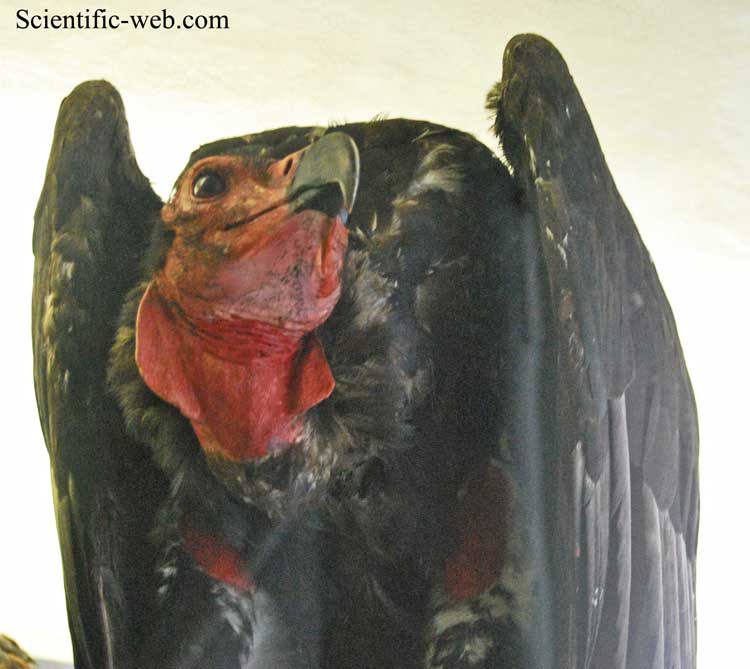
Sarcogyps calvus, Photo: Michael Lahanas
Superregnum: Eukaryota
Cladus: Unikonta
Cladus: Opisthokonta
Cladus: Holozoa
Regnum: Animalia
Subregnum: Eumetazoa
Cladus: Bilateria
Cladus: Nephrozoa
Superphylum: Deuterostomia
Phylum: Chordata
Subphylum: Vertebrata
Infraphylum: Gnathostomata
Megaclassis: Osteichthyes
Cladus: Sarcopterygii
Cladus: Rhipidistia
Cladus: Tetrapodomorpha
Cladus: Eotetrapodiformes
Cladus: Elpistostegalia
Superclassis: Tetrapoda
Cladus: Reptiliomorpha
Cladus: Amniota
Classis: Reptilia
Cladus: Eureptilia
Cladus: Romeriida
Subclassis: Diapsida
Cladus: Sauria
Infraclassis: Archosauromorpha
Cladus: Crurotarsi
Divisio: Archosauria
Cladus: Avemetatarsalia
Cladus: Ornithodira
Subtaxon: Dinosauromorpha
Cladus: Dinosauriformes
Cladus: Dracohors
Cladus: Dinosauria
Ordo: Saurischia
Cladus: Eusaurischia
Subordo: Theropoda
Cladus: Neotheropoda
Cladus: Averostra
Cladus: Tetanurae
Cladus: Avetheropoda
Cladus: Coelurosauria
Cladus: Tyrannoraptora
Cladus: Maniraptoromorpha
Cladus: Maniraptoriformes
Cladus: Maniraptora
Cladus: Pennaraptora
Cladus: Paraves
Cladus: Eumaniraptora
Cladus: Avialae
Infraclassis: Aves
Cladus: Euavialae
Cladus: Avebrevicauda
Cladus: Pygostylia
Cladus: Ornithothoraces
Cladus: Ornithuromorpha
Cladus: Carinatae
Parvclassis: Neornithes
Cohors: Neognathae
Cladus: Neoaves
Ordo: Accipitriformes
Familia: Accipitridae
Subfamilia: Aegypiinae
Genus: Sarcogyps
Species: Sarcogyps calvus
Name
Sarcogyps calvus (Scopoli, 1786)
References
Deliciae florae faunae insubricae 2 p 85 BHL.
IUCN: Sarcogyps calvus (Critically Endangered)
Vernacular names
العربية: نسر أحمر الرأس
অসমীয়া: ৰজা শগুণ
বাংলা: এশীয় রাজ শকুন
brezhoneg: Gup penn ruz
català: Voltor cap-roig
Cebuano: Sarcogyps calvus
čeština: Sup holohlavý
Cymraeg: Fwltur pengoch Asia
Deutsch: Kahlkopfgeier
Ελληνικά: Σαρκόγυπας
English: Red-headed vulture
Esperanto: Ruĝkapa vulturo
español: Buitre cabecirrojo
فارسی: کرکس سرسرخ
suomi: Kalmokorppikotka
français: Vautour royal
עברית: נשר אדום-ראש
हिन्दी: लाल सिर वाला गिद्ध
magyar: Pirosfejű keselyű
한국어: 붉은머리독수리
മലയാളം: കാതിലക്കഴുകൻ
मराठी: राज गिधाड
Bahasa Melayu: Burung Hereng Kepala Merah
नेपाली: सुन गिद्ध
Nederlands: Indische oorgier
polski: Sęp łysy
پنجابی: راج گدھ
русский: Индийский ушастый гриф
svenska: rödhuvad gam
தமிழ்: செந்தலைக்கழுகு
ไทย: พญาแร้ง
Türkçe: Kırmızı başlı akbaba
Tiếng Việt: Kền kền đầu đỏ
中文: 黑兀鹫
The red-headed vulture (Sarcogyps calvus), also known as the Asian king vulture, Indian black vulture or Pondicherry vulture,[2] is an Old World vulture mainly found in the Indian subcontinent, with small disjunct populations in some parts of Southeast Asia.
Description
It is a medium-sized vulture of 76 to 86 cm (30 to 34 in) in length, weighing 3.5–6.3 kg (7.7–13.9 lb) and having a wingspan of about 1.99–2.6 m (6.5–8.5 ft).[3][4] It has a prominent naked head: deep-red to orange in the adult, paler red in the juvenile. It has a black body with pale grey band at the base of the flight feathers. The sexes differ in colour of the iris: males have a paler, whitish iris, whilst in females it is dark brown.[5]
Red headed vulture female at Ranthambore
The red-headed vulture is very similar in appearance to its larger relative the Lappet-faced vulture in Africa and Arabia, even being historically placed in the genus Torgos [6]
A female red-headed vulture (left) and a Lappet-faced vulture (right). Both have similar anatomical features including skull shapes and the dangling skin lappets. They are believed to be closely related
Taxonomy and systematics
This is a species of Old World vulture found in the Indian subcontinent. It has no subspecies.
Distribution and habitat
This gaudy-faced vulture was historically abundant, range widely across the Indian subcontinent, and also eastwards to south-central and south-eastern Asia, extending from India to Singapore. Today the range of the red-headed vulture is localized primarily to northern India. It is usually in open country and in cultivated and semi-desert areas. It is also found in deciduous forests and foothills and river valleys. It is usually found up to an altitude of 3000m from sea level.[7]
Conservation status
Main article: Indian vulture crisis
The red-headed vulture used to be declining, but only slowly; in 2004 the species was uplisted to near threatened from least concern by the IUCN. The widespread use of the NSAID diclofenac in veterinary medicine in India has caused its population to collapse in recent years, however. Diclofenac is a compound now known to be extremely poisonous to vultures. The red-headed vulture population has essentially halved every other year since the late 1990s, and what once was a plentiful species numbering in the hundreds of thousands has come dangerously close to extinction in less than two decades. Consequently, it was uplisted to critically endangered in the 2007 IUCN Red List.[1]
Several NSAIDs have been found to be harmful to scavenging birds. Diclofenac, carprofen, flunixin, ibuprofen and phenylbutazone were associated with mortality. Meloxicam has thus far been found to be "Vulture-Safe" and its use in veterinary treatment of livestock is being encouraged.[8][9]
The red-headed vulture has started becoming more harder to come by as it is being hunted down. Places like Cambodia have put together special programs to help critically endangered vulture species. There has been evidenced compiled that showed hunters have started “ the use of poisons in hunting practices”,[10] which has led to the population analysis showing “that since 2010 populations of the White-rumped Vulture (Gyps bengalensis) and Red-headed Vulture (Sarcogyps calvus) have declined, while the Slender-billed Vulture (Gyps tenuirostris) may also have started to decline since 2013”.[10]
References
BirdLife International (2021). "Sarcogyps calvus". IUCN Red List of Threatened Species. 2021: e.T22695254A205031246. Retrieved 30 August 2022.
Ali, S. (1993). The Book of Indian Birds. Bombay: Bombay Natural History Society. ISBN 978-0-19-563731-1.
WWF- Red-headed Vulture (2011).
Raptors of the World by Ferguson-Lees, Christie, Franklin, Mead & Burton. Houghton Mifflin (2001), ISBN 0-618-12762-3
Naoroji, Rishad (2006). Birds of Prey of the Indian subcontinent. pp. 282–287.
"Vultures=29 September 2022". Researchgate.
Ferguson-Lees, James; David A. Christie (2001-09-17). Raptors of the world. Houghton Mifflin Harcourt. pp. 443–444. ISBN 978-0-618-12762-7.
Cuthbert, Richard; et al. "NSAIDs and scavenging birds: potential impacts beyond Asia's critically endangered vultures". The Royal Society. Retrieved 11 May 2011.
Milius, Susan (4 February 2006). [tp://www.sciencenews.org/view/generic/id/7025/title/Bird-Safe_Rx_Alternative_drug_wont_kill_Indias_svultures "Bird-Safe Rx: Alternative drug won't kill India's vultures"]. ScienceNews. 169 (#5): 70. Retrieved 11 May 2011.
Loveridge, Robin. “Poisoning Causing the Decline in South-East Asia’s Largest Vulture Population.” , 8 Mar. 2019, https://www.cambridge.org/core/journals/bird-conservation-international/article/poisoning-causing-the-decline-in-southeast-asias-largest-vulture-population
Retrieved from "http://en.wikipedia.org/"
All text is available under the terms of the GNU Free Documentation License

